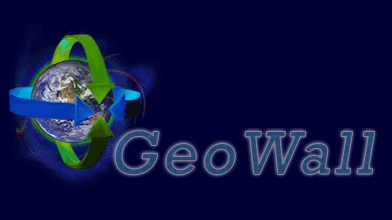GeoWall
March 1st, 2001 - August 1st, 2005
Categories: Devices

About
The GeoWall, based on AGAVE technology, is low-cost, non-tracked, passive-stereo system that allows distributed audiences to view and interact with 3D immersive content. While it can be applied to many applications, the Geoscience community immediately saw its potential for supporting Earth Science curricula in the classroom and in geological fieldwork, and created a consortium to deploy this technology to its members; hence, the name GeoWall. The GeoWall Consortium currently documents 70 installations in US universities, laboratories and government research institutions. These sites include offices of the USGS, SCEC and various geology and astronomy departments at campuses throughout the US.
The GeoWall aids in the understanding of Earth Science data with 3D models supported by low-cost, classroom-based virtual-reality and visualization techniques. A minimal system specification is a 1Ghz CPU with 512MB RAM and a NVIDIA GeForce4 Ti 4600 or Quadro4 graphics card connected to two InFocus 530 projectors. The system may be configured as either front or rear projection, and requires passive polarized filters and glasses.
The GeoWall supports EVL-developed Immersaview software, developed to view 3D content running on Windows 2000 / XP, Redhat Linux 7.3, SuSE Linux and Mac OS-X operating systems. Immersaview is an Open Inventor model viewer that can visualize a single dataset or interact with an animation of scientific data.
The GeoWall was officially introduced to a team of geologists and geophysicists at the first GeoWall Summit held at EVL in March 2001. A second GeoWall Summit was convened at University of Minnesota in June 2002, where new software for geometry visualization and volume rendering was introduced. Also discussed was the newest GeoWall hardware configuration - which now uses an NVIDIA GeForce4 Ti 4600 or NVIDIA Quadro4 card.